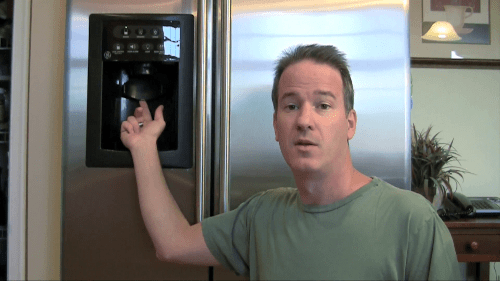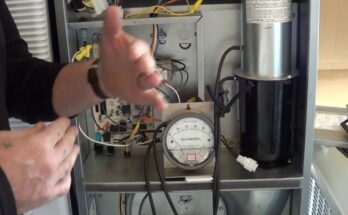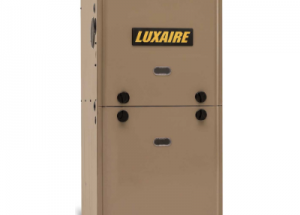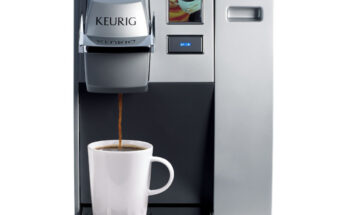To troubleshoot a GE Profile refrigerator, first check the power supply and temperature settings. Verify that the door seals are tight.
A well-functioning refrigerator is crucial for maintaining fresh food. The GE Profile series offers advanced features, but occasional issues can arise. Common problems include temperature fluctuations, unusual noises, and water leaks. Addressing these issues promptly can prevent food spoilage and extend the appliance’s life.
Start by inspecting the power supply and ensuring the refrigerator is plugged in securely. Check the temperature settings to make sure they are correct. Ensure the door seals are clean and tight to maintain optimal cooling. Regular maintenance and quick troubleshooting can keep your GE Profile refrigerator running efficiently.

Credit: samedayappliancerepair.com
Common Issues
GE Profile refrigerators are reliable, but they can have issues. Common problems can disrupt your daily routine. Knowing how to troubleshoot can save time and money.
One common issue is the refrigerator not cooling. This can spoil food. Ensure the temperature settings are correct. Check if the door seals are intact. Broken seals let warm air in.
Another issue is the condenser coils. Dirty coils can’t cool efficiently. Clean them with a brush or vacuum. If the refrigerator still doesn’t cool, check the evaporator fan motor. A faulty motor needs replacement.
Sometimes the thermistor might be the problem. It measures the fridge’s temperature. Replace it if it’s faulty. Lastly, check the start relay on the compressor. A bad relay can stop the fridge from cooling.
Ice Maker Malfunctions
The ice maker might stop making ice. First, ensure the ice maker is on. Check the water supply line. It must be connected and not kinked. A blocked or frozen line can prevent ice production.
Inspect the water filter. A clogged filter reduces water flow. Replace it every six months. The ice maker module might fail. This component controls ice production. If defective, consider replacing it.
Another issue is the ice level control board. It detects the ice level. Replace it if it malfunctions. Sometimes, the ice mold heater fails. This heater releases the ice cubes. If it’s broken, replace it for proper function.
Initial Diagnostics
Experiencing issues with your GE Profile Refrigerator can be stressful. Performing initial diagnostics can help identify and fix common problems. This section will guide you through some essential checks.
Power Supply Check
Start by ensuring that your refrigerator is receiving power. Here’s how to check:
- Verify that the refrigerator is plugged in securely.
- Check the circuit breaker or fuse box.
- Ensure the outlet is functioning by testing it with another device.
If the power supply is fine, move on to the next step.
Temperature Settings
Incorrect temperature settings can cause many issues. Follow these steps:
- Open the refrigerator and locate the temperature controls.
- Ensure the fridge is set to the recommended 37°F (3°C).
- Check the freezer setting, it should be around 0°F (-18°C).
If the temperatures are set correctly and the problem persists, you may need further troubleshooting.
Cooling Problems
Having cooling problems with your GE Profile refrigerator can be frustrating. The issue might stem from various components. Identifying the root cause is essential for quick fixes. Here we discuss some common issues and solutions.
Evaporator Fan Issues
The evaporator fan plays a crucial role in the cooling process. It circulates cold air from the freezer to the refrigerator. If the fan fails, your refrigerator may not cool properly.
- Check if the fan motor is running. A faulty motor can cause cooling issues.
- Inspect the fan blades for any obstructions. Remove any debris blocking the blades.
- Listen for unusual noises. A noisy fan may indicate a problem.
Replacing the fan motor might be necessary if it’s not functioning well.
Condenser Coil Maintenance
The condenser coils are located at the back or bottom of the refrigerator. They dissipate heat from the unit. Dirty coils can lead to poor cooling efficiency.
- Unplug the refrigerator for safety before cleaning the coils.
- Use a vacuum cleaner or a coil brush to remove dust and dirt.
- Clean the coils every six months to maintain optimal performance.
Regular maintenance ensures your refrigerator cools efficiently.
| Component | Symptoms | Solution |
|---|---|---|
| Evaporator Fan | No cooling, unusual noise | Check motor, remove obstructions |
| Condenser Coils | Poor cooling efficiency | Clean coils regularly |
Ice Maker Troubles
Is your GE Profile refrigerator not making ice? Ice maker issues are frustrating. But don’t worry! This section will help you fix common ice maker problems. Follow the steps below to troubleshoot your ice maker.
Water Supply Line
The water supply line is crucial for ice production. Check if the line is properly connected. Ensure it’s not kinked or blocked. A kinked line restricts water flow. A blocked line prevents water from reaching the ice maker.
Inspect the line for any visible damage. Replace it if necessary. A clean and clear water supply line ensures smooth ice production.
Ice Maker Assembly
The ice maker assembly includes several parts. Each part must function correctly. If any part is faulty, the ice maker won’t work. First, check the ice mold. Ensure it’s clean and free from ice buildup.
Next, inspect the ice maker motor. The motor should run smoothly. Listen for any unusual noises. Replace the motor if it’s malfunctioning.
Lastly, check the ice maker’s control module. Ensure it’s receiving power. Use a multimeter to test for continuity. If the control module is faulty, replace it.
Proper maintenance of the ice maker assembly is key. Regular checks and timely replacements keep your ice maker working efficiently.
Unusual Noises
Hearing strange sounds from your GE Profile refrigerator? These noises can be alarming. Let’s break down some common culprits.
Compressor Sounds
The compressor is the heart of your refrigerator. It works to keep your fridge cool. It can produce various noises during operation. Here are some typical sounds:
- Humming: This is normal. It means the compressor is running.
- Clicking: The compressor clicks when it turns on or off. This is also normal.
- Buzzing: This can happen during the defrost cycle. It usually lasts a few minutes.
If you hear loud or unusual sounds, it might be a problem. Ensure the fridge is level. Check for vibrations against walls or cabinets. If the noise persists, consider calling a technician.
Fan Blade Obstructions
The fan blades are crucial for airflow. They help maintain the right temperature. Sometimes, obstructions can cause unusual sounds. Here’s how to troubleshoot:
- Unplug the refrigerator to ensure safety.
- Locate the fan, usually behind a panel.
- Check for any visible obstructions.
- Remove any debris or ice buildup.
Ensure the blades spin freely. If they seem damaged, you might need a replacement. Regular maintenance can prevent these issues.

Credit: m.youtube.com
Water Leaks
Experiencing water leaks from your GE Profile Refrigerator can be frustrating. Leaks can lead to water damage and mold growth. Identifying the source of the leak is crucial. Two common sources are the drain pan and the door seal.
Drain Pan Overflow
The drain pan collects excess water from the defrost cycle. If the pan overflows, water leaks onto the floor. Check if the pan is cracked or full. Follow these steps:
- Locate the drain pan under the refrigerator.
- Carefully remove the pan.
- Empty the water into a sink.
- Inspect the pan for cracks or damage.
- Replace the pan if damaged.
If the pan is full again quickly, check for a clogged drain line.
Door Seal Inspection
A damaged door seal can cause leaks. The seal ensures the door closes tightly. Follow these steps to inspect the seal:
- Open the refrigerator door.
- Examine the seal for cracks or gaps.
- Close the door on a piece of paper.
- Pull the paper out. If it slides easily, the seal is faulty.
Replace the door seal if necessary. A proper seal prevents leaks and keeps the fridge efficient.
Error Codes
Your GE Profile refrigerator is a reliable kitchen companion. But sometimes, it displays error codes. These codes indicate specific issues. Understanding these codes can help you troubleshoot effectively.
Decoding Error Messages
Each error code has a unique meaning. Here’s a table to decode common error messages:
| Error Code | Description |
|---|---|
| PF | Power failure. Check the power supply. |
| CC | Cooling system issue. Service may be needed. |
| FF | Freezer issue. Inspect the freezer components. |
| DE | Defrost system error. Manual defrost may help. |
Reset Procedures
Resetting your GE Profile refrigerator can clear minor glitches. Here are simple steps to reset:
- Unplug the refrigerator from the power outlet.
- Wait for at least five minutes.
- Plug the refrigerator back in.
- Check if the error code reappears.
If the code persists, further inspection may be needed. For complex issues, contacting GE support is advisable.

Credit: m.youtube.com
Maintenance Tips
Maintaining your GE Profile Refrigerator is essential for its longevity and efficiency. Proper upkeep ensures that your appliance runs smoothly and prevents unexpected breakdowns. Here are some maintenance tips to help you keep your refrigerator in top shape.
Regular Cleaning
Regular cleaning is vital for your refrigerator’s performance. Follow these steps to keep it spotless:
- Wipe down the interior: Use a soft cloth and mild detergent.
- Clean the door seals: Inspect and clean the seals to ensure a tight fit.
- Defrost the freezer: Remove ice buildup regularly to maintain efficiency.
Regular cleaning prevents odors and keeps your food fresh. Make it a monthly routine.
Professional Service
Scheduling professional service can save you from major problems. Here’s why it’s beneficial:
| Service Type | Frequency | Benefits |
|---|---|---|
| General Inspection | Once a year | Identifies potential issues early |
| Thermostat Check | Once a year | Ensures optimal temperature |
| Compressor Service | Every 2 years | Improves efficiency |
Professional technicians can spot and fix problems that you might miss. This keeps your refrigerator running smoothly.
These maintenance tips will help you ensure your GE Profile Refrigerator operates efficiently. Take care of your refrigerator, and it will take care of your food.
Frequently Asked Questions
What Is The Most Common Problem With Ge Profile Refrigerators?
The most common problem with GE Profile refrigerators is temperature control issues, causing uneven cooling or warming.
How To Reset Ge Profile Refrigerator Control Panel?
To reset the GE Profile refrigerator control panel, unplug it for 30 seconds. Then, plug it back in.
How Do I Run Diagnostics On My Ge Profile Refrigerator?
To run diagnostics on your GE Profile refrigerator, press and hold the “Energy Saver” and “Lighting” buttons for 8-10 seconds. Follow on-screen instructions to complete the diagnostics.
What Causes A Ge Profile Refrigerator To Stop Cooling?
A GE Profile refrigerator may stop cooling due to a faulty thermostat, dirty condenser coils, or a malfunctioning compressor. Regular maintenance can prevent these issues.
Conclusion
Troubleshooting your GE Profile refrigerator doesn’t have to be daunting. Follow these tips for quick and easy fixes. Regular maintenance can prevent future issues. Keep your fridge running smoothly and extend its lifespan. Don’t hesitate to consult the user manual or a professional if needed.
Your kitchen will thank you!



